We explore the Cretaceous Period and its divisions. In addition, we discuss its characteristics, and explain how animals and plants evolved during this period.
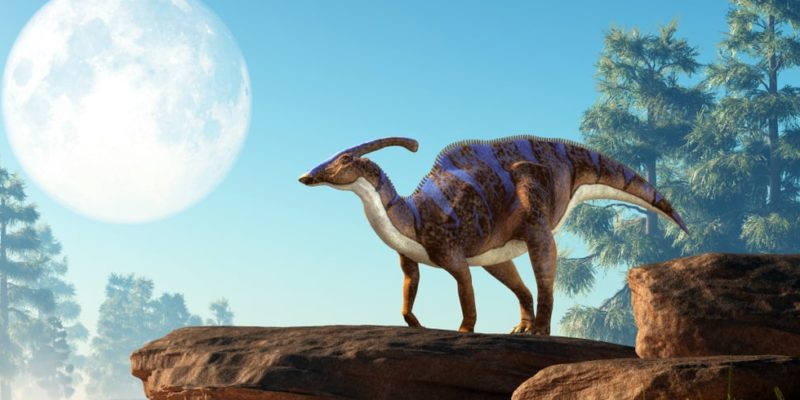
What was the Cretaceous Period?
The Cretaceous is the last period of the Mesozoic Era, which spanned from 252.2 to 66 million years ago. It is the third period of the era, succeeding the Triassic and the Jurassic.
The Cretaceous Period began about 144 million years ago and ended 65 million years ago. It spanned 79 million years, making it the longest period in the geological history of Earth.
During the Cretaceous, the breakup of the supercontinent Pangea continued, having begun in the Jurassic Period. The Atlantic and Indian Oceans also continued to expand. In terms of climate, temperatures were high on the continents, since continental drift had not yet moved them closer to colder polar latitudes.
The end of the Cretaceous Period and the Mesozoic Era was marked by the so-called K-Pg event, which caused the extinction of dinosaurs and numerous other species. The causes of this event are unknown, though it is believed to have been triggered by the impact of a large meteorite on the Yucatán Peninsula, in present-day Mexico.
The term Cretaceous is derived from the Latin word cretaceus, meaning "chalk". The name was introduced by Belgian geologist Jean d'Omalius d'Halloy in 1822, who detected the presence of white limestone and chalk formations in northern France and southern England dating from this geologic period.

- See also: Paleozoic Era
Characteristics of the Cretaceous Period
The main characteristics of the Cretaceous Period are:
- It began 144 million years ago and ended 65 million years ago.
- It was the longest period in the geological history of Earth.
- The climate was predominantly hot and humid.
- Dinosaurs dominated land and sea.
- The breakup of Pangea continued, and continents moved closer to their current positions.
- New inland seas formed within Pangea.
- Angiosperm species, i.e. flowering plants with seeds and fruits, first appeared.
- Pollinating insects such as bees emerged.
- The K-Pg mass extinction event occurred, coinciding with the end of the period.
Division of the Cretaceous Period
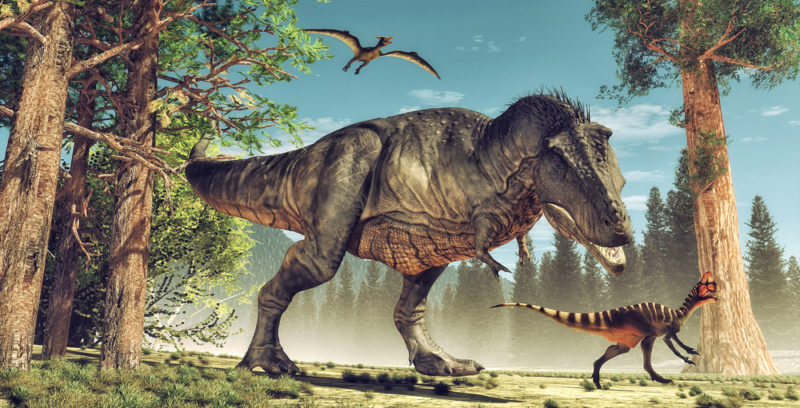
The Cretaceous Period is divided into two epochs or series comprising six ages or stages:
- Lower or Early Cretaceous. It began in the wake of the Jurassic Period, about 144 million years ago, and extended until about 100.5 million years ago. It includes the Berriasian, Valanginian, Hauterivian, Barremian, Aptian, and Albian ages.
- Upper or Late Cretaceous. It began around 100.5 million years ago and lasted until about 65 million years ago. It comprises the Cenomanian, Turonian, Coniacian, Santonian, Campanian, and Maastrichtian ages.
Geology of the Cretaceous Period
The breakup of the supercontinent Pangea, which had already begun in the Jurassic Period, intensified during the Cretaceous. The initial rift gave rise to two continents, Laurasia and Gondwana, separated by the Tethys Sea. As the period progressed, the continents continued to drift, moving closer to their current positions.
Rising sea levels and continental drift contributed to the formation of inland seas, which in turn brought about increased humidity levels over much of the planet. During the Cretaceous, Earth’s continental landmass occupied only 18 %, while the remaining 82 % was covered by sea. Currently, continental landmass accounts for 29 %, which indicates that during the Cretaceous the rise in sea level had submerged vast continental landmasses.
Climate of the Cretaceous Period
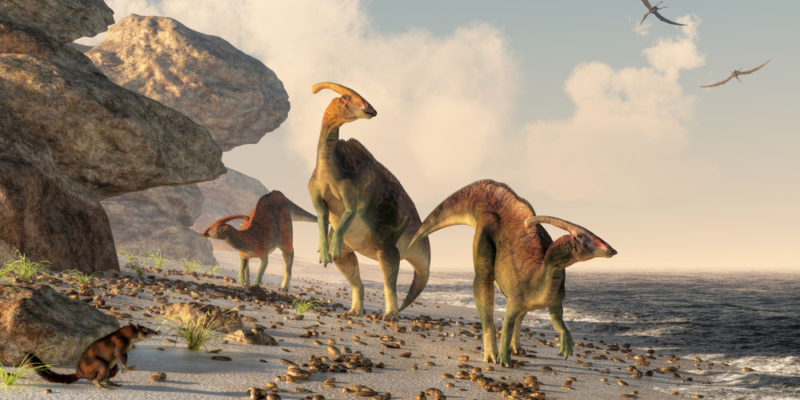
The climate during the Cretaceous Period would have been relatively warm and humid over much of Earth's surface. This is based on the absence of ice caps at the poles and fossil and paleobotanical records from the period, which show a high biodiversity of terrestrial and marine life.
Concentration of greenhouse gases in the atmosphere, especially carbon dioxide, were higher during the Cretaceous than at present. This may have contributed to an increase in global temperatures and would account for the absence of ice sheets in the polar regions.
Ocean temperature was also higher than it is today. This contributed to the rise in atmospheric moisture on the planet, and enabled warm water marine species to thrive and spread in most of the oceans.
Flora and fauna of the Cretaceous Period
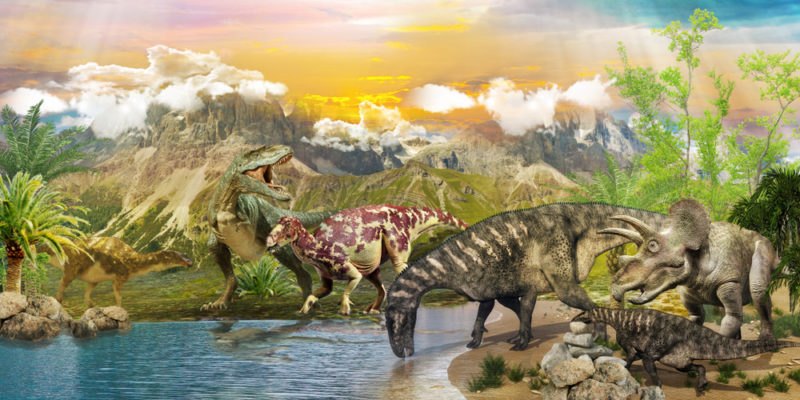
The start of the Cretaceous Period was a turning point in plant life: the first plants with flowers, seeds and fruits, known as angiosperms, appeared. Their evolutionary success was such that in only 20 million years, the pollen levels of these plants increased from 1% to 40%. Thus, by the end of the period there were already 50 of the 500 known modern families, including beeches, figs, birches, hollies, magnolias, oaks, palms, sycamores, walnuts, and willows.
The work of insects was key in pollination, possibly attracted by plants' sweet secretions and striking colors. The first Cretaceous bee, for example, was discovered in Myanmar in 2006. It was preserved in amber and is believed to be over 100 million years old. It can therefore be stated that insects and angiosperms evolved together.
A similar situation occurred with gymnosperm plants, which the large herbivorous dinosaurs consumed. They developed thorns, unpleasant taste, and other defense mechanisms to prevent the upper parts, which received more sunlight, from being eaten. This evolutionary pressure resulted in an extraordinary diversification of plant species.
In terms of fauna, animal life in the Cretaceous reached significant levels of diversification as a result of the competition that had begun in the Jurassic.
The seas were populated by species of ammonites, fish of various sizes, and large aquatic reptiles like the plesiosaur, characterized by its extremely long neck, and the mosasaur, both fierce predators. Likewise, sharks, rays, and turtles first appeared, replacing the extinct ichthyosaurs.
The transformation of winged dinosaurs into birds continued. Mammals, in turn, remained a small, unimportant, and minor group, though much more diversified than in previous periods.
On land, the animal world continued to be dominated by dinosaurs, boasting massive predators such as Tyrannosaurus rex, Carnotaurus, Spinosaurus, and the raptors (Velociraptor and Deinonychus).
During the Cretaceous, the deposits of animal and plant organic matter were formed. They would later become the world's great oil reserves, including those of the Persian Gulf, the Gulf of Mexico, and the Venezuelan coastline.
Mass extinction or K-Pg extinction event
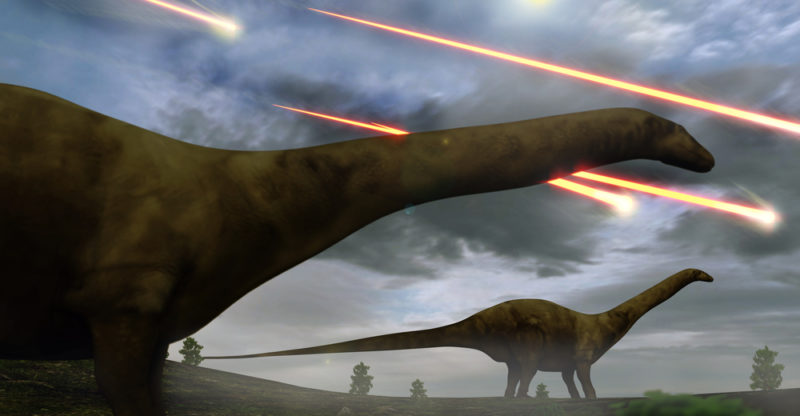
The K-Pg (Cretaceous-Paleogene) event is the name given to the mass extinction of animal and plant species that occurred at the end of the Cretaceous Period. In this event, all land and marine dinosaurs, along with most other species, suddenly became extinct.
It is known that the majority of small body size terrestrial reptiles (salamanders, turtles, snakes, crocodiles), insects, amphibians, and placental mammals survived, as well as a significant portion of marine invertebrate species.
Various hypotheses have been proposed regarding the causes of this mass extinction:
- Climatic events. Given that the majority of the affected species were tropical while those of the high latitudes remained relatively intact, it can therefore be assumed that much of the life of the period was not able to adapt to the shift in temperature produced by the movement of continents towards colder areas.
- Meteorite impact. This is the most widely accepted theory, proposed by Luis and Walter Alvarez. Due to the abundant iridium found among Cretaceous sediments, it is presumed that the extinction would have been caused by the impact of a meteorite in Yucatán, Mexico, since this metal is rare on Earth. The meteorite would have generated a dust layer in the atmosphere, which would have blocked sunlight, significantly cooling the planet. Furthermore, the impact would have caused earthquakes, tsunamis, and wildfires, which would have contributed to the extinction of the species.
- Extraterrestrial causes. Various theories attribute the extinction to extraplanetary causes, such as nearby supernovas or solar phenomena, which might have dramatically changed the amount of radiation on the planet.
Explore next:
References
- Fisher, A. (2022). Así fue el período Cretácico: la era en la que el cambio climático acabó con el dominio de los dinosaurios. National Geographic en Español. https://www.ngenespanol.com/
- National Geographic. (2010). Período Cretácico. https://www.nationalgeographic.es/
- Tarbuck, E. y Lutgens, F. (2005). Ciencias de la Tierra. Una introducción a la geología física. Pearson Educación.
Was this information useful to you?
Yes NoThank you for visiting us :)